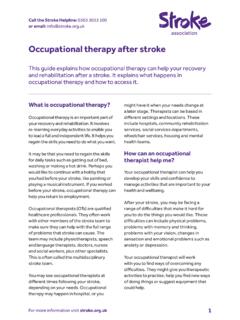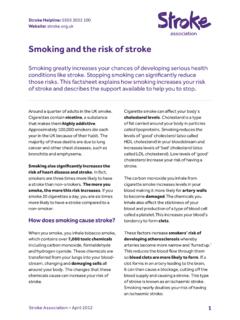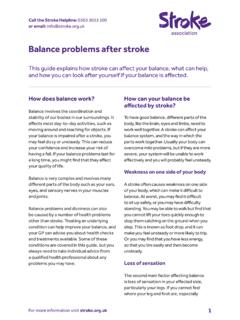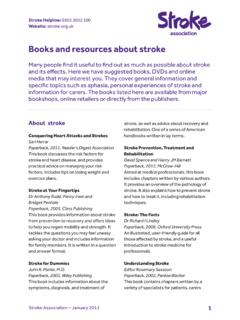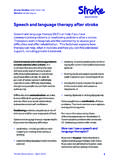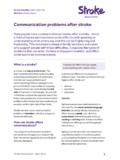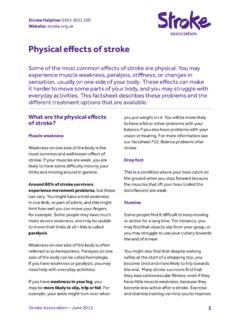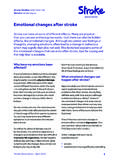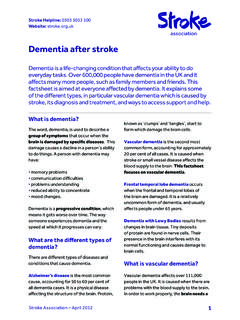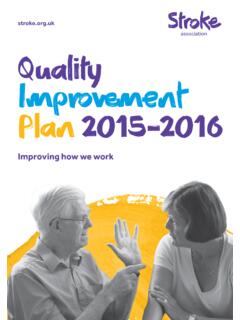Transcription of Apraxia following stroke: Identification and interventions ...
1 Apraxia following stroke : Identification and interventions UK stroke Forum 29th Nov 2016. Th r se Lebedis (Jackson). Consultant Occupational Therapist in stroke NHS Grampian 1. ROY AND SQUARE PROCESSING MODEL (1996). PRAXIS. SENSORY CONCEPTUAL PRODUCTION. PERCEPTUAL SYSTEM SYSTEM. SYSTEM Knowledge of: Involves: - Object function - Organise and control Distinguish - Action response selection between visual, - Sequencing - Execution (correct auditory and object actions force, direction and information timing). Roy & Square 1996 2. Apraxia . `A cognitive motor planning disorder leading to an inability to perform actions in the absence of weakness or sensory loss`. Prevalence 1/3 of those in rehabilitation centres and nursing homes following left hemisphere stroke Donkervoort 2000. 3. Apraxia . A disorder of learned, voluntary actions resulting from neurological impairment Rothi LJG and Heilman KM (1997). Ideomotor Apraxia Ideational Apraxia 4.
2 Ideomotor Apraxia A disorder in the initiation and execution of planned sequences of movement. The concept of the task is understood but the movements lack the correct force, direction and timing in order to achieve a motor goal. 5. Ideational Apraxia A disorder in the performance of skilled activity because the concept of the action related to the object is impaired. A disturbance in the conceptual organisation of actions 6. Butler J. How comparable are tests of Apraxia ? Clinical Rehabilitation 2002; 16: 389-398 (2002). until a `gold standard` test of Apraxia is found, that we don't rely on, just one test of Apraxia for diagnosis and that we consider the functional and behavioural indices in ADL tasks as more clinically relevant than pure test scores . the need for `expert judgement` to interpret errors remains apparent . 7. Behavioural observations Tasks which can be used in a functional setting Making a cold drink Putting paper in an envelope Hole punching paper and putting it in an A4.
3 File. Zwinkels et al (2004). 8. Dovern J. Diagnosis and treatment of upper limb Apraxia ' Neurol (2012) 259 1269-1283. Screening tool AST Apraxia Screen of TULIA (Vanbellingen et al). CAS Cologne Apraxia Screen (Weiss et al). Clinical diagnosis Apraxia test by De Renzi et al Test of Upper Limb Apraxia (TULIA). Research/scientific purposes Apraxia test by Alexander et al Test Battery by Bartolo et al The Florida Apraxia Battery & Revised Sydney (FABERS). 9. Measurement of disability in people with Apraxia Observational method of assessment using four activities of daily living Activity performance is scored on a four point rating scale These descriptors assess the disability caused by Apraxia as they focus on the stage at which the performance of the activity breaks down, rather than the cause. van Heugten et al (2000). 10. Ideomotor Apraxia Performance errors Spatial orientation errors Temporal imprecision errors (timing errors). Errors of the force of movement Poor distal differentiation Body part as object Gestural enhancement Vocalisation 11.
4 Ideational Apraxia Performance errors Inappropriate object use Sequencing errors - omission / incomplete Blending sequences together Action overshoots what's required Action remains incomplete Perseveration 12. Cognitive Rehabilitation Approaches Restitution aimed at reducing specific cognitive deficits Specific skills training aimed at improving functional task ability *Substitution or cognitive strategy training . teach people new ways to deal with daily life problems 13. Activities in context Clark et al 1994. Appropriate environment Park S et al 1994. Errorless learning Goldenberg and Hagman 1998. Task specific training Goldenberg & Hagmaan 1998; Wilson 1998. Goal directed activity Goldenberg & Hagmaan 1998. Structured tasks Wilson 1998. Practice and repetition of meaningful tasks Goldenberg & Hagmaan 1998; Wilson 1998. West C et al. ` interventions for motor Apraxia following stroke (review) The Cochrane Collaboration 2008, Issue 1.
5 Objective of review to determine which interventions targeted at motor Apraxia reduce disability Included RCTs of therapeutic intervention for motor Apraxia in stroke 3 trials, 132 patients Results evidence of a small but short lived therapeutic effect in the two studies that reported change in ADLs . effect did not persist in the longer term Conclusion insufficient evidence to support or refute the effectiveness of specific therapeutic interventions for motor Apraxia after stroke . 15. Strategy training - Apraxia Stage of activity Intervention Initiation Instruction Execution Assistance Control Feedback Donkervoort M et al. (2001) Efficacy of strategy training in left hemisphere stroke patients with Apraxia : a randomised clinical trial. Neuropsychological Rehabilitation, 11, 549-566. Transfer effects For patients to function as independently as possible at home and in society, two types of transfer of treatment effects are needed Tasks taught in the rehab setting should be transferred to the home setting Transfer of intervention effects from trained to non trained (related) tasks is important in terms of the clinical success of a therapy programme as not all difficulties can be dealt with in therapy programmes Geusgens C et al 2006 & 2007.
6 THANK YOU. Email: 18. References Butler J. How comparable are tests of Apraxia ? Clinical Rehabilitation 2002;. 16: 389-398 (2002). Clark et al (1994) Spatial deficits in limb Apraxia . Brain 117, 1093 1106. De Renzi et al (1980) Imitating gestures: a quantitative approach to ideomotor Apraxia . Archives of Neurology, 37, 6-18. Donkervoort M, Dekker J, Stehmann-Saris J, Deelman BG. (2001) Efficacy of strategy training in left hemisphere stroke patients with Apraxia ; a randomised clinical trial. Neuropsychological Rehabilitation 11(5); 549-566. Dovern J Diagnosis and treatment of upper limb Apraxia ' Neurol (2012) 259. 1269-1283. Geusgens C, Van Heugten C, Cooijmans J, Jolles J, and Van den Heuvel W. Transfer effects of a cognitive strategy training for stroke patients with Apraxia : An exploratory study Neuropsychological Rehabilitation. 2006, 16(2), 213-229. Geusgens C, Van Heugten C, Donkervoort M, Van den Ende E, Jolles J, and Van den Heuvel W.
7 Transfer of training effects in stroke patients with Apraxia . Journal of Clinical and Experimental neuropsychology 2007, 29. (8), 831-841. 19. Goldenberg G, & Hagmann S, (1998) Therapy of activities of daily living in patients with Apraxia . Neuropsychological Rehabilitation, 8, (2) 123-141. Rothi and Heilman Eds. (1997). Apraxia . The Neurospychology of Action. East Sussex: The Psychology Press. Roy EA (1996) hand preference, manual asymmetries & limb Apraxia . In Elliott EA Roy eds. Manulal asymmetries in motor control. Boca Raton, FL. CRC Press Vanbellingen T, Kersten B, Van de Winckel A, Bellion M, Baronti F, Muri R, Bohlhalter S (2011) A new bedside test of gestures in stroke : the Apraxia screen of TULIA (AST). J Neurol Neurosurg Psychiatry 82(4):389 392. van Heugten CM, Dekker J, Deelman BG, van Dijk AJ, Stehmann Saris JC. and Kinebanian A (1998) Outcome of strategy training in stroke patients with Apraxia , a phase II study : Clinical Rehabilitation: 12 :216 225.
8 Van Heugten, Bekker J, Deelman BG, van Djil AJ, Stehmaan-Saris, FC &. Kinebanian A. A Diagnostic Test for Apraxia in stroke Patients: Internal consistency and Diagnostic value. The Clinical Neuropsychologist 1999, 13, No 2 182 -192. van Heugten, Dekker J, Deelman BG, van Djil AJ, Stehmaan-Saris, FC &. Kinebanian A Assessment of disabilities in stroke patients with Apraxia : Internal consistency and Inter-observer reliability. The Occupational Therapy Journal of research. 1999. Vol 19, No1. 20.. Smania N, Girardi F, Domenicali C, Lora E, Aglitori S. (2000) The rehabilitation of limb Apraxia : a study in left brain damaged patients. Archives of Physical Medicine and Rehabilitation 81: 379-88. Smania N, Aglioti SM, Girardi F, Tinazzi M, Fiaschi A, Cosentino A, Corato E. (2006) Rehabilitation of limb Apraxia improves daily life activities in patients with stroke . Neurology 67:2050 2052. West C et al. ` interventions for motor Apraxia following stroke (review).
9 The Cochrane Collaboration 2008, Issue 1. Wilson B (1988) Remediation of Apraxia following an anaesthetic accident. In: J West, P Spinks, eds. Case studies in clinical psychology. Bristol: John Wright Zwinkels A, Geusgens C, van de Sande P, van Heugten C. Assessment of Apraxia : inter rater reliability of a new Apraxia test, association between Apraxia and other cognitive deficits and prevalence of Apraxia in a rehabilitation setting. Clinical Rehabilitation. 2004;18: 819 827. 21.
